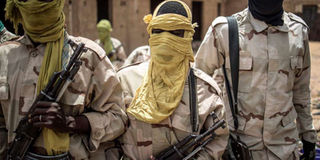Premium
The Fulanis: Spotlight on Mali's jihadist insurgency

A group of Fulani militiamen stand ready with their weapons on July 6, 2019, at an informal demobilisation camp in Sevare run by Sekou Bolly, a local Fulani businessman whose goal is to take away young Fulani from the noose of jihadism. PHOTO | MARCO LONGARI | AFP
What you need to know:
- In the Mopti region, the Fulani are the biggest ethnic group and the most recruits to Al-Qaeda-linked jihadist cells.
- The deep poverty and isolation of the Fulani people have made many vulnerable to the siren call of the jihad.
- According to the UN, 70,000 people have fled their homes in Mopti over jihad-related violence.
Bamako
For centuries, the Fulani people trod the paths of the Sahel with their cattle, largely unnoticed by the rest of the world.
Today, the world's attention has turned to this ancient herding community as many of its members have been ensnared in a deadly jihadist insurgency spreading from Mali's restive north to its centre.
In the Mopti region, the Fulani -- also called Peuls -- are the biggest ethnic group and the most recruits to Al-Qaeda-linked jihadist cells, such as the notorious Katiba Macina.
HOLY WAR
The group's Fulani leader Amadou Koufa has called on his "brothers" throughout West Africa to join his holy war against "non-believers".
The deep poverty and isolation of the Fulani people have made many vulnerable to the siren call of the jihad -- an appeal that today is disseminated at lightning speed on WhatsApp and Facebook.
The herders' prominent role in the jihadist revolt has ignited long-standing rivalries, based on access to land, with farmer groups.
JIHAD VIOLENCE
The conflict has turned a once-peaceful tourist region into a no-go area for visitors, its highways sown with roadside bombs, and swathes of the countryside are littered with abandoned burned-out villages.
Hundreds have been killed and the situation is getting worse by the day -- the number of people who have fled their homes in Mopti has quadrupled over the last year to 70,000, according to the UN.
The violence in Mali, in turn, has spread to neighbouring Niger and Burkina Faso, stirring anxiety among the coastal states of West Africa that they could be next in line.





